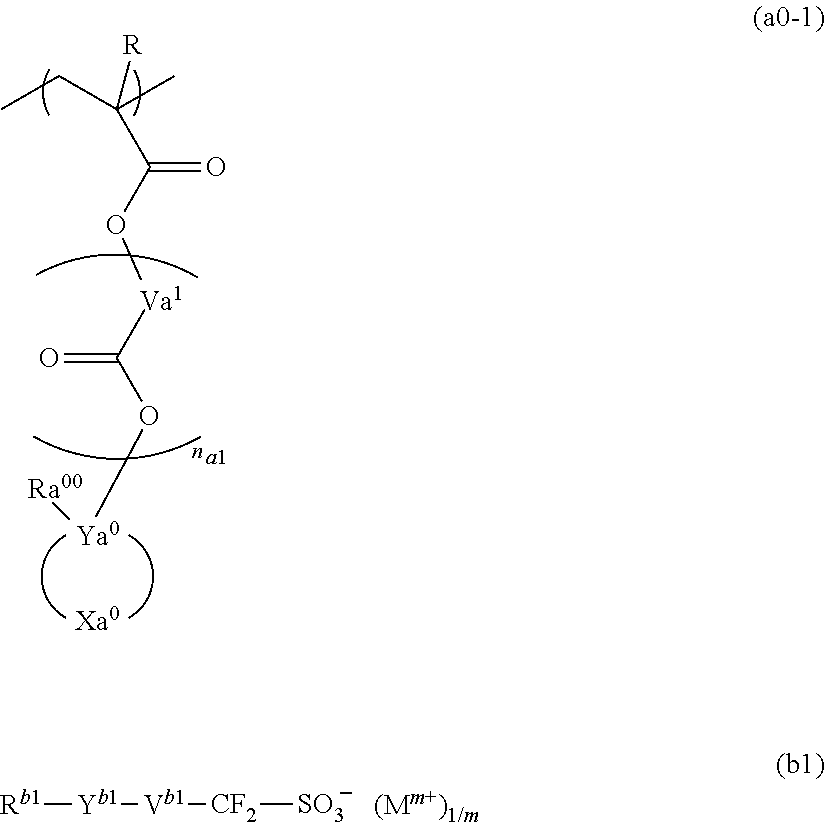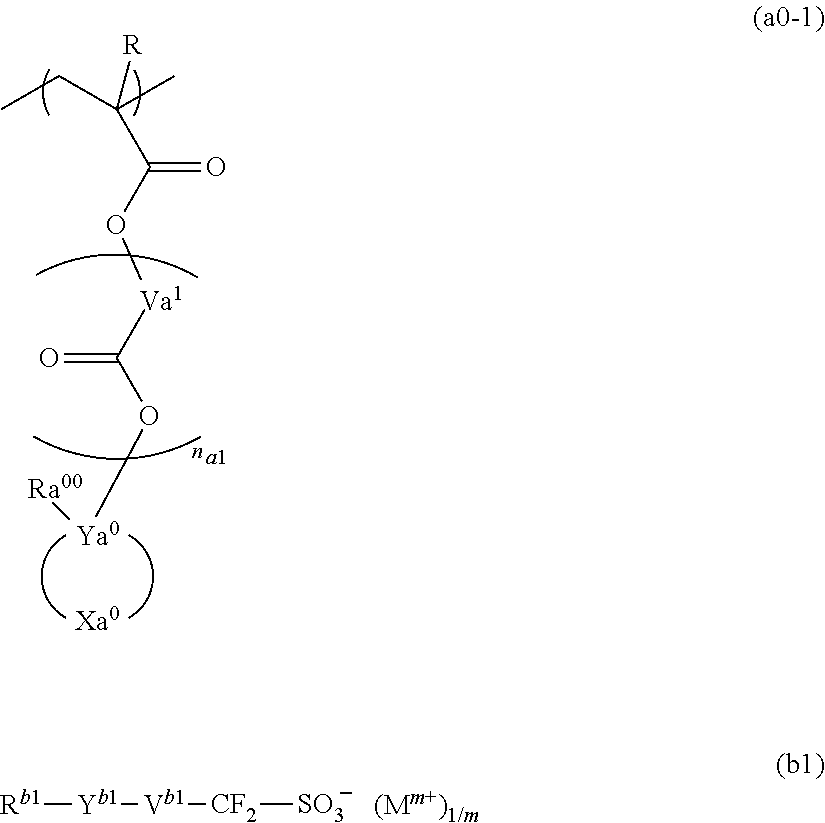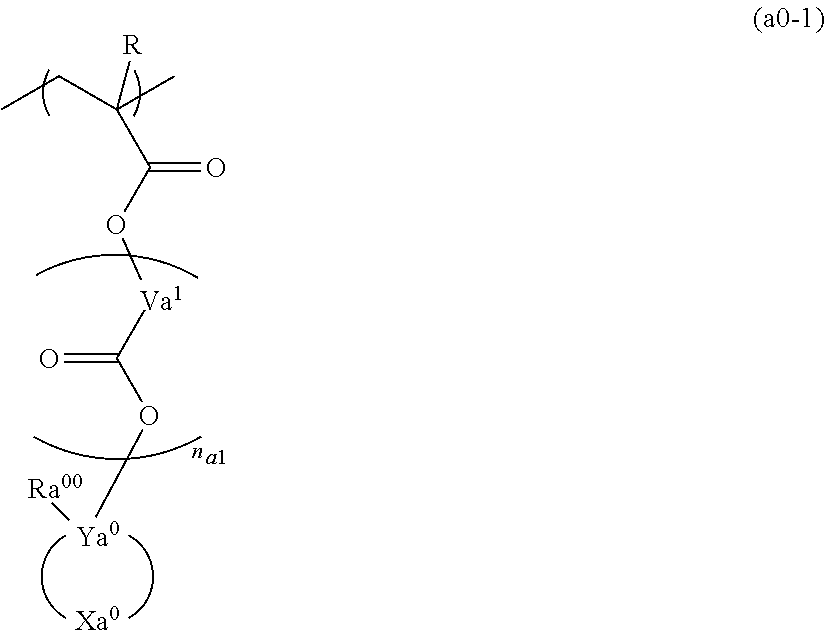Resist composition and method for forming resist pattern
a composition and resist technology, applied in the field of resist composition and resist pattern formation, can solve the problems of difficult to satisfy any properties, less likely to obtain the desired resist pattern shape, etc., and achieve the effect of excellent shaped resist pattern, improved lithography properties, and high sensitivity
- Summary
- Abstract
- Description
- Claims
- Application Information
AI Technical Summary
Benefits of technology
Problems solved by technology
Method used
Image
Examples
synthesis example 1
[0745]Oxalyl chloride (6.15 g) and dimethyl formamide (0.03 g) were added dropwise to a mixture of dehydrocholic acid (15.0 g) and dichloromethane (135 g), and the resultant was stirred at room temperature for 3 hours. The obtained reaction solution was concentrated, thereby obtaining a compound (15.6 g) represented by general formula (a).
[0746]Identification of the compound represented by general formula (a) obtained by the above synthesis will be described below.
[0747]1H-NMR (DMSO-d6) δ (ppm)=3.02-2.80 (m, 5H) 2.39-1.80 (m, 14H), 1.66-1.53 (m, 1H), 1.52-1.21 (m, 7H), 1.07 (S, 3H), 0.86 (d, 3H)
synthesis example 2
[0748]A compound (11.5 g) represented by general formula (a), acetonitrile (105 g), and a salt (9.92 g) and triethylamine (2.63 g) represented by general formula (b) were mixed and stirred at room temperature for 24 hours. The obtained reaction solution was filtered and concentrated. The obtained residue was dissolved in tetrahydrofuran (hereinafter referred to as “THF”) (100 g), then t-butyl methyl ether (50.0 g) was added dropwise thereto to thereby precipitate a white solid. Thereafter, the solvent was removed by decantation, and a white solid was collected. After dissolving the white solid in THF (100 g), t-butyl methyl ether (50.0 g) was added dropwise to the resulting solution to thereby precipitate a white solid. The same operation was repeated four times so as to obtain a white solid, then the white solid, dichloromethane (95.0 g), and ion exchanged water (50.0 g) were added and stirred at room temperature for 30 minutes, and then liquid separation was performed so as to col...
synthesis example 3
[0752]The salt (14.0 g) represented by general formula (c), the salt (9.88 g) represented by general formula (d), dichloromethane (186 g), and ion exchanged water (88.9 g) were mixed, and stirred for 30 minutes at room temperature, and then liquid separation was performed so as to extract an organic layer. Ion exchanged water (186 g) was added to the collected organic layer, and the mixture was stirred at room temperature for 30 minutes, and then separated, thereby extracting the organic layer. This washing operation was repeated three times. The obtained organic layer was concentrated, thereby obtaining a salt (14.9 g) represented by general formula (e).
[0753]Identification of the compound represented by general formula (e) obtained by the above synthesis will be described below.
[0754]1H-NMR (DMSO-d6) δ (ppm)=7.77-7.98 (m, Ph, 11H), 4.50-4.40 (m, 2H), 3.15-2.95 (m, 4H), 2.55-1.64 (m, 16H), 1.55-1.55-1.05 (m, 12H), 0.75 (d, 3H)
[0755]19F-NMR(DMSO-d6) δ(ppm)=−101.2 (s, 2F), −106.8 (t,...
PUM
| Property | Measurement | Unit |
|---|---|---|
| solubility | aaaaa | aaaaa |
| structure | aaaaa | aaaaa |
| resist composition | aaaaa | aaaaa |
Abstract
Description
Claims
Application Information
 Login to View More
Login to View More - R&D
- Intellectual Property
- Life Sciences
- Materials
- Tech Scout
- Unparalleled Data Quality
- Higher Quality Content
- 60% Fewer Hallucinations
Browse by: Latest US Patents, China's latest patents, Technical Efficacy Thesaurus, Application Domain, Technology Topic, Popular Technical Reports.
© 2025 PatSnap. All rights reserved.Legal|Privacy policy|Modern Slavery Act Transparency Statement|Sitemap|About US| Contact US: help@patsnap.com



